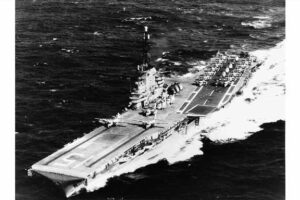The Fates of All 21 American Aircraft Carriers in WWII

World War II undeniably marked the rise of American fleet carriers, underscoring their indispensable role in the conflict. Between 1941 and 1945, the United States Navy commissioned several classes of aircraft carriers, namely the Lexington, Ranger, Wasp, Yorktown, and Essex classes, which became instrumental in establishing air and naval superiority.
To determine the fate of every American aircraft carrier that was active in World War II, 24/7 Wall St. referenced The Naval Vessel Registry’s database of WWII ships, among other sources. We listed the aircraft carriers alphabetically. We included supplemental information from various military and historical sources about the class of each aircraft carrier and when it was commissioned.
Yorktown-class carriers, including the USS Yorktown (CV-5), USS Enterprise (CV-6), and USS Hornet (CV-8), were some of the earliest American carriers to see action during the war. Their design was notable for defensive measures and substantial aircraft capacity. The Battle of Midway in June 1942 highlighted their value as both the Yorktown and Enterprise demonstrated their supreme striking capabilities. See if some of them are among the most highly decorated U.S. Navy ships of WWII.
The Lexington-class carriers, namely the USS Lexington (CV-2) and USS Saratoga (CV-3), also made a significant impact during the early stages of the war. Originally designed as battle cruisers, these vessels were converted into carriers. Despite numerous updates to their design, the Lexington-class carriers were limited in speed and aircraft capacity compared to their successors. However, they played a vital role in the Battle of the Coral Sea, contributing to repelling the Japanese offensive.
Later classes such as the Essex and Independence class carriers demonstrated greater aircraft capacity, survivability, and resilience. The Essex-class, including the esteemed USS Essex (CV-9) and USS Intrepid (CV-11), facilitated the Navy’s shift to amphibious warfare, participating in notable battles such as the Battle of the Philippine Sea and the Battle of Leyte Gulf.
These carriers, through their innovative designs and adaptability, established a new paradigm in naval warfare, allowing the U.S. to move through the Pacific with authority. Most of these carriers survived the war, but a few did not. These are famous U.S. ships that sunk in WWII.
Click here to see the fate of every American aircraft carrier of World War II.
Sponsored: Tips for Investing
A financial advisor can help you understand the advantages and disadvantages of investment properties. Finding a qualified financial advisor doesn’t have to be hard. SmartAsset’s free tool matches you with up to three financial advisors who serve your area, and you can interview your advisor matches at no cost to decide which one is right for you. If you’re ready to find an advisor who can help you achieve your financial goals, get started now.
Investing in real estate can diversify your portfolio. But expanding your horizons may add additional costs. If you’re an investor looking to minimize expenses, consider checking out online brokerages. They often offer low investment fees, helping you maximize your profit.
Source: Read Full Article
